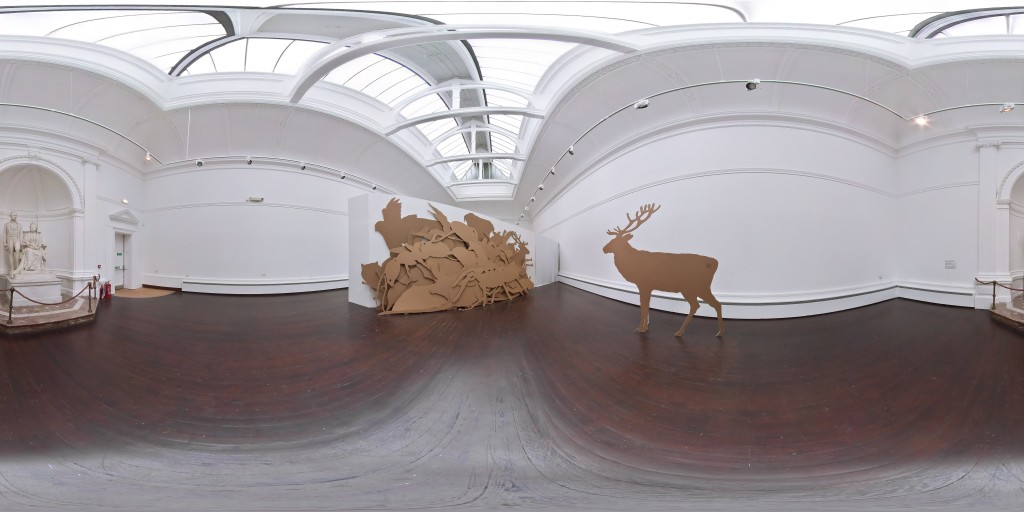virtual tour: uncertainty in the city
January6th

for the Exhibition Tour click here:
360_radioanimal.html

for the Exhibition Tour click here:
360_radioanimal.html
The exhibition Uncertainty in the City is now closed. The following is a contemporary description of the show.
‘The installation occupies the two main and stunningly beautiful rooms of the Gallery. The first and larger room has been bisected by a custom-built diagonal wall, advancing knife-like towards and past the visitor on entrance. Along the facing surface, the wall is loaded with over sixty loudspeakers. Each speaker carries a story, stories or accounts of human/animal contact. At times the wall is alive with the sound of many voices – at others a single voice commands attention – the human voices are interspersed with those of echolocating bats – but at any time, by moving close, the listener can single out a narrative of choice and so move between accounts of fear, anxiety, respect and amazement, all generated through encounters between humans and other species.
Facing this wall of sound is a triptych of photographs taken in the office of the Pest Control Department for Lancashire and Morecambe District Council. The impression is one of quiet – but of a place where silence may be broken at any time – calls are taken, reports are fielded and where exasperation or nerves perhaps are calmed. An acknowledgement of threat and warning is evident by posters on the walls depicting common pests, displayed alongside newspaper articles concerning human intolerance and feelings of discomfort towards others in our midst.
Moving into the next room in which the light is generally dimmed, the visitor is aware of a red glow emanating from a neon text on the wall to the left. It reads simply, coming into garden from woods behind house. In the centre of the space is a Victorian display case within which five printed sheets are laid and pinned out – each bearing a series of single-line accounts indicating the serial presence or proximity of an animal or animals within urban gardens as they are reported to pest control officers. The reports, brief though they are, in most instances also give an indication of the nature of the callers’ concern, anxiety or fear.
At the far end of this room, with one corner on the floor and tilted not far from the horizontal is a video projection. The image is of a garden, alternately from a fixed position at night and superimposed with panned sequences of the same garden taken during the day. Somewhere, something is stirring. The noises of activity are there, in the underbrush perhaps, sometimes insistent, sometimes barely perceptible. Luck, or diligence, rewards the viewer with an occasional glimpse of an uninvited visitor.
Moving back to the main Gallery, behind the speaker wall, a final surprise awaits. For those familiar with the Storey, the imposing marble statue of Victoria and Albert is there as expected, but facing them, against the wall is stacked a jumble of enormous cardboard representations – a clamour of silhouetted cut out beasts suggesting chaos and the anarchy of other wills at loose. To one side is a single standing form – a stag. On the rump of the stag is the printed mark of a rubber stamp revealing a coat of arms. On the architrave surrounding the statue, a note provides a clue’. Released in 1873 and 1874 by the Queensland Acclimatisation Society, red deer were a gift from Queen Victoria to provide “additional food and sport” to the growing colony. In 1977, during the silver jubilee of Queen Elizabeth II, an image of the animal was added to the Queensland coat of arms in acknowledgement of the original gift and in order to represent the Old World. The Queensland Government has in recent years declared feral red deer a pest species because of their growing numbers and the increasing damage they are causing to agriculture, forestry and the environment. Grazing deer damage parks, residential gardens and fences in outer urban areas.
The installation of the show is well underway. The assistance at the Gallery has been spectacular and we thank Jeff for construction, Simon for assistance with everything, Simon and Nick for the neon install, Hanni for painting and clearing, Tim Lambert for his sterling technical work on the audio and Karen for her attention to detail on the installation of the speakers. Thanks also to Sam for the dimming of the light and projector suction. This has been a complex show to install and it’s not over yet…
As urban dwellers we tend to suppress our awareness of the degree to which we share space with other creatures. If we were to make a physical cut – a cross-section through our house for instance, imagine what multitudes we would find embedded in its fabric – and if we were seriously to extend that awareness to our gardens, our sense of being ‘outnumbered’ would be profound.